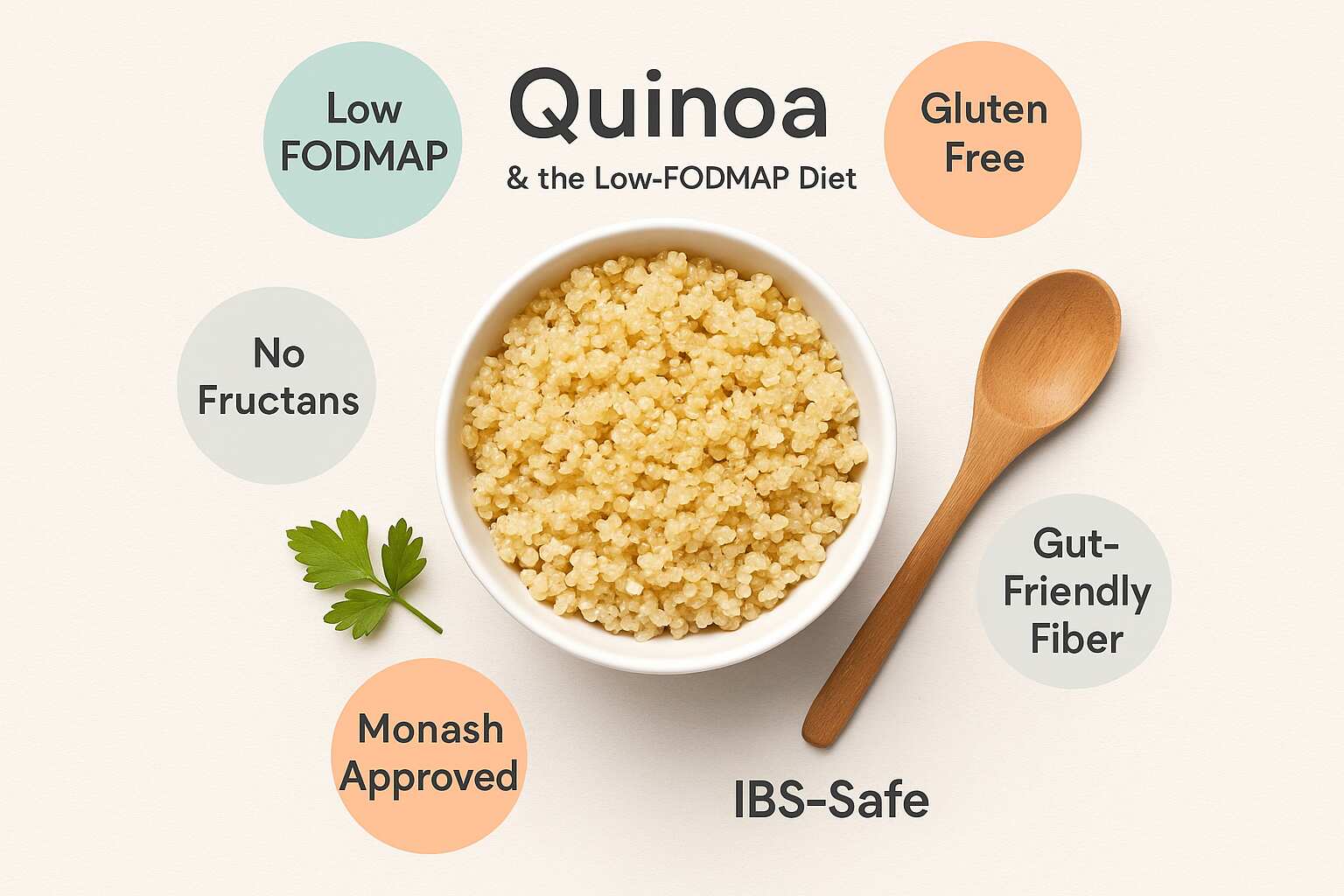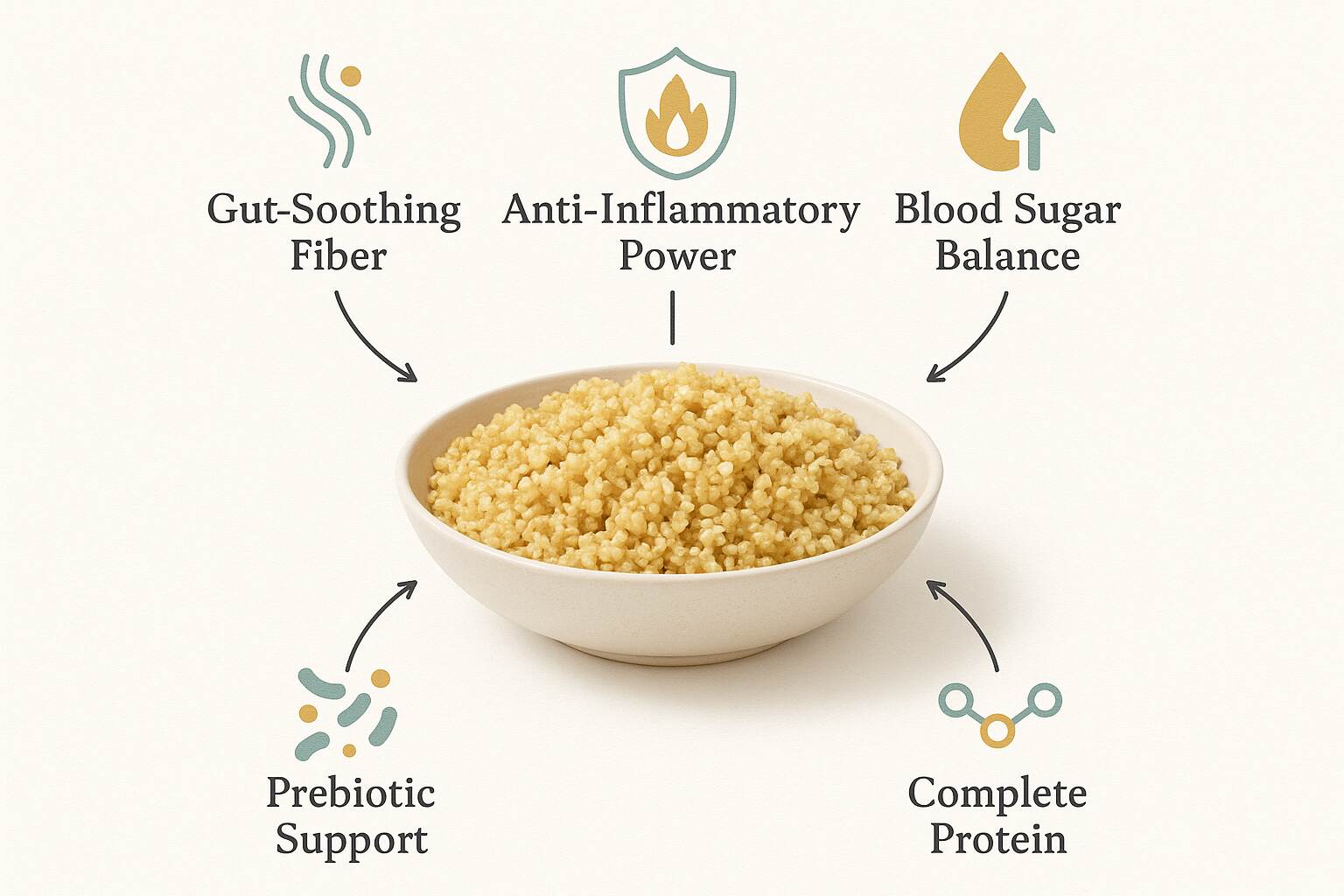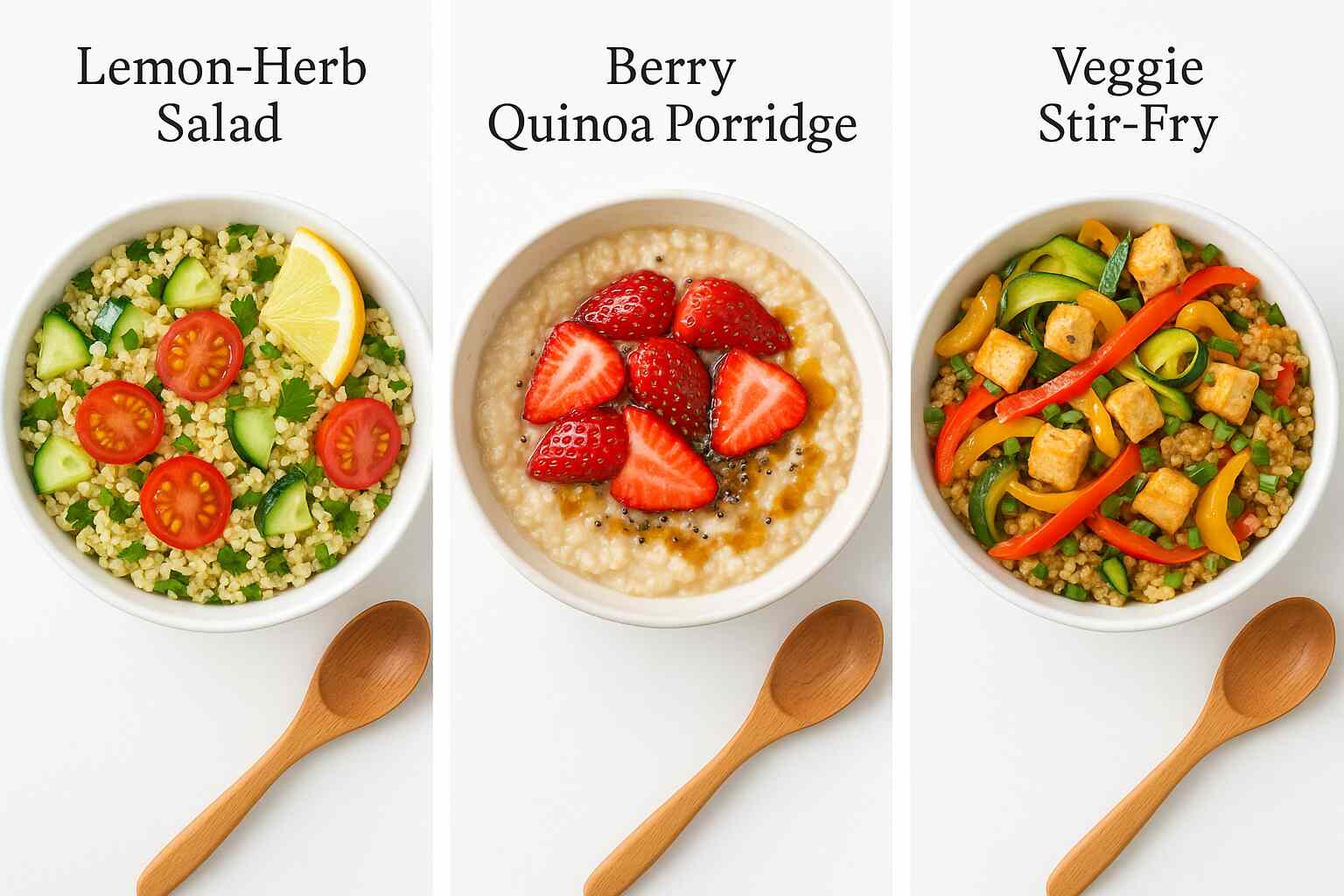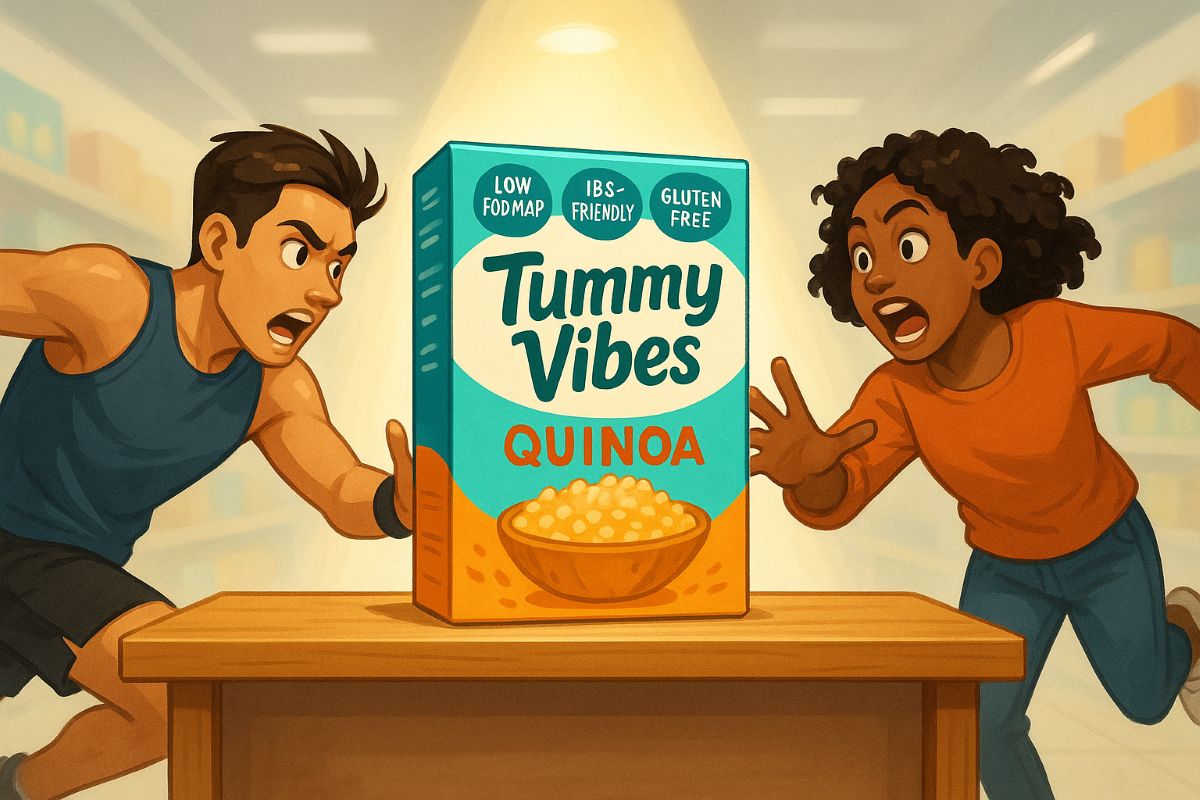- Quinoa IBS is a naturally gluten-free, low FODMAP seed perfect for soothing IBS symptoms.
- Packed with complete protein, gut-regulating fiber, and anti-inflammatory compounds.
- Monash-approved serving size (½ cup cooked) keeps FODMAPs in check.
- Versatile: breakfast porridge, salads, stir-fries—batch-cook and freeze for easy meals.
- Includes 3 IBS-friendly quinoa recipes to get you started.
Table of Contents
1. Introduction
Living with IBS means walking a dietary tightrope every day. One misstep—and your gut can rebel with bloating, cramps, or unpredictable bathroom trips. Learn more about IBS symptoms and triggers from the Mayo Clinic’s IBS overview.
Quinoa IBS sufferers know how hard it is to find grains that fuel energy without triggering bloating, cramps, or bathroom marathons. You need a go-to grain that’s gentle yet nourishing—and that’s exactly what quinoa delivers.
Unlike wheat or barley, quinoa is naturally low in FODMAPs and gluten-free, yet rich in gut-soothing fiber, complete protein, and essential minerals. Monash University’s Low-FODMAP guide for grains confirms a ½-cup serving is safe for most IBS sufferers.
2. What Is Quinoa?
Quinoa (pronounced KEEN-wah) isn’t technically a cereal grain—it’s the edible seed of the Chenopodium quinoa plant, native to the Andean region of South America.
- Botanical origin: A member of the amaranth family, related to spinach and beets.
- Cooking basics:
- Rinse under cold water to remove bitter saponins.
- Simmer with a 1:2 ratio (quinoa:liquid) for 15 minutes.
- Rest covered for 5 minutes; fluff with a fork.
- Nutritional snapshot (½ cup cooked):
- Protein: 4 g (complete protein with all nine essential amino acids)
- Fiber: 2.6 g (soluble + insoluble blend)
- Magnesium: 59 mg (15% DV)
- Iron: 1.4 mg (8% DV)
- Manganese, phosphorus, folate, B-vitamins
Quinoa’s nutrient density helps fill the gaps many IBS sufferers face—energy dips, micronutrient deficiencies, and gut irritation.

3. Quinoa & the Low-FODMAP Diet
Understanding FODMAPs
FODMAPs are short-chain carbs that can exacerbate IBS by drawing water into the gut or fermenting rapidly in the colon. They include:
- Oligosaccharides: Fructans (wheat, onion), GOS (legumes)
- Disaccharides: Lactose (dairy)
- Monosaccharides: Excess fructose (honey, apples)
- Polyols: Sorbitol, mannitol (stone fruits, sugar alcohols)
Monash-Approved Serving
Monash University tests confirm ½ cup cooked quinoa (≈90 g) is safe for most people with IBS. A larger portion may exceed your personal FODMAP threshold, so stick to the recommended amount.
Monash University has tested hundreds of foods—see their full low-FODMAP guide for grains and cereals to understand serving sizes and safety thresholds.
Why Quinoa Beats Other Grains
- Minimal fermentable sugars: Unlike wheat or rye, quinoa’s fructan content is negligible.
- Balanced fiber profile: Soluble fiber soothes; insoluble fiber adds gentle bulk.
- Rich in nutrients: Protein, fiber, and minerals—without a FODMAP overload.
- Gut-friendly fermentation: Supports healthy microbiome without gas-causing spikes.
By making quinoa a staple, you choose a seed that fuels you without fear of flare-ups.

4. Health Benefits for IBS
Soluble vs. Insoluble Fiber
Quinoa offers a gut-friendly fiber blend:
- Soluble fiber forms a gentle gel, slowing digestion and soothing the intestinal lining.
- Insoluble fiber adds bulk, promoting regular bowel movements without harsh scraping.
Anti-Inflammatory Compounds
- Saponins: Plant compounds with antioxidant and anti-inflammatory effects. Rinsing removes the bitter coating but retains health benefits.
- Flavonoids (Quercetin & Kaempferol): These antioxidants modulate immune response and reduce gut inflammation.
A 2016 Frontiers in Nutrition study found quinoa extract lowered inflammatory markers in the gut, suggesting potential benefits for human IBS sufferers.
Blood Sugar Stabilization
Spikes in blood glucose can trigger gut spasms. Quinoa’s low glycemic index (GI ≈ 53) ensures a steady energy release, preventing sharp insulin peaks that stress the digestive system².
Prebiotic Effects & Microbiome Support
Quinoa’s fibers act as prebiotics—food for beneficial gut bacteria. Research shows increased Bifidobacteria levels and improved gut barrier function after incorporating quinoa into the diet³. A healthy microbiome means fewer flare-ups.
5. Practical Advantages of Quinoa
- Versatility
- Breakfast: Hot porridge or parfaits
- Lunch: Grain bowls, salads
- Dinner: Stir-fries, side dishes
- Naturally Gluten-Free & Nutrient-Dense
- Safe for celiac disease and non-celiac gluten sensitivity.
- Complete protein: all nine essential amino acids.
- Quick Cooking & Batch Prep
- Cooks fully in 20 minutes.
- Doubles/triples easily; portion and freeze for grab-and-go meals.
- Flavor-Friendly Base
- Neutral, slightly nutty flavor.
- Absorbs herbs, spices, and dressings beautifully.
With these advantages, low FODMAP quinoa becomes an effortless addition to any IBS-friendly meal plan.

6. 3 IBS-Friendly Quinoa Recipes
Explore more safe-staple meals in our Safe Staples: IBS-Friendly collection.
a) Lemon-Herb Quinoa Salad (Safe Staples)
Prep & Cook Time: 5 min prep + 15 min cook
Servings: 2
Ingredients:
- 1 cup cooked quinoa
- ½ cup diced cucumber
- ½ cup halved cherry tomatoes
- 2 Tbsp lactose-free feta, crumbled
- 1 Tbsp chopped parsley
- Juice of ½ lemon
- 1 Tbsp extra-virgin olive oil
- Salt & pepper, to taste
Instructions:
- In a large bowl, combine quinoa, cucumber, tomatoes, feta, and parsley.
- Whisk lemon juice, olive oil, salt, and pepper; drizzle over salad.
- Toss gently and serve chilled or at room temperature.
IBS Tip: Stick to one cup per serving to stay within low-FODMAP limits.
b) Warm Quinoa Porridge with Berries (Flare-Up Friendly)
Prep & Cook Time: 5 min prep + 10 min cook
Servings: 1
Ingredients:
- ½ cup cooked quinoa
- ½ cup lactose-free milk (or almond milk)
- ¼ cup fresh strawberries, sliced
- 1 Tbsp chia seeds
- 1 Tbsp pure maple syrup
Instructions:
- In a small pot, combine quinoa and milk; warm over medium heat.
- Stir in chia seeds; cook for 5 minutes, stirring occasionally.
- Transfer to a bowl; top with strawberries and drizzle with maple syrup.
IBS Tip: Enjoy immediately—letting porridge sit can increase fermentation.
c) Quinoa Veggie Stir-Fry Bowl (Fitness Fuel)
Prep & Cook Time: 10 min prep + 10 min cook
Servings: 2
Ingredients:
- 1 cup cooked quinoa
- 1 Tbsp garlic-infused olive oil (FODMAP-safe)
- 1 cup diced bell peppers (red & green)
- 1 cup zucchini ribbons
- 100 g firm tofu or chicken breast, cubed
- 2 Tbsp tamari (gluten-free soy sauce)
- 1 Tbsp chopped chives
Instructions:
- Heat oil in a skillet over medium. Sauté tofu/chicken until browned.
- Add peppers and zucchini; cook 3–4 minutes until tender-crisp.
- Stir in quinoa and tamari; toss until heated through.
- Garnish with chives and serve hot.
IBS Tip: Swap tofu for chicken if legumes aren’t well tolerated.
7. Tips for Your IBS Toolkit
- Batch-Cook & Freeze: Cook 2–3 cups of quinoa at once. Portion into single-serving containers and freeze.
- Flavor Variations:
- Herb Infusion: Stir in fresh basil, cilantro, or dill after cooking.
- Spice Boost: Add smoked paprika, turmeric, or cumin for depth.
- Smart Pairings: Combine quinoa with lean proteins (chicken, fish, firm tofu) and low-FODMAP veggies like carrots, spinach, or bell peppers.
These simple hacks keep your meal routine fresh, varied, and IBS-friendly.
8. Common Questions
-
Is quinoa low FODMAP?
Yes—quinoa is low FODMAP because Monash University tests confirm a ½-cup cooked serving stays within safe FODMAP limits. It contains minimal fermentable oligosaccharides and no fructans, making it an excellent IBS-friendly grain choice for sensitive tummies.
-
Can people with IBS eat quinoa IBS safely?
Yes—quinoa IBS sufferers can enjoy quinoa in moderation. A Monash-approved portion of ½ cup cooked quinoa provides gut-soothing soluble and insoluble fiber without triggering flare-ups. Start with this serving size to gauge your personal tolerance before increasing.
-
What is the recommended quinoa serving size for IBS?
The recommended quinoa serving size IBS threshold is ½ cup cooked (≈90 g). Monash University guidelines list this amount as low FODMAP. Sticking to this portion helps prevent excess fermentation and digestive discomfort while still delivering protein and fiber.
-
How do I cook quinoa to reduce IBS symptoms?
To minimize saponins and potential irritation, rinse quinoa thoroughly under cold water and toast it in a dry pan for 2–3 minutes before simmering. Then cook 1 cup quinoa in 2 cups water for 15 minutes, rest 5 minutes, and fluff. This method supports low FODMAP quinoa recipes.
-
What other IBS-friendly grains can I eat?
Besides quinoa, you can enjoy rice, oats, buckwheat, millet, and cornmeal. These IBS-friendly grains are low in FODMAPs and gentle on the gut. For more ideas and full recipes, visit our Safe Staples: IBS-Friendly Pantry page.
-
Where can I find authoritative low-FODMAP guidelines?
For the most up-to-date, evidence-based recommendations, consult Monash University’s High and Low FODMAP Foods guide. It offers detailed serving sizes and thorough testing results to help manage your IBS diet effectively.
9. Conclusion & Call-to-Action
Quinoa IBS success comes down to choosing a grain that nourishes without discomfort. Its low-FODMAP nature, balanced fiber, and nutrient power make it the ideal ally for gut comfort. Ready to make quinoa your go-to grain? Try one of our three recipes, then share your favorite quinoa creation in the comments below. Don’t forget to subscribe for weekly gut-loving recipes and explore our Flare-Up Friendly Meals for more IBS-friendly inspiration!

